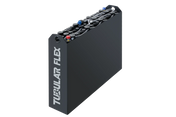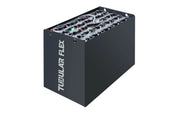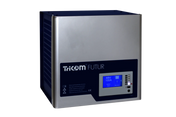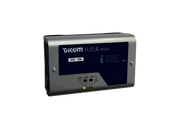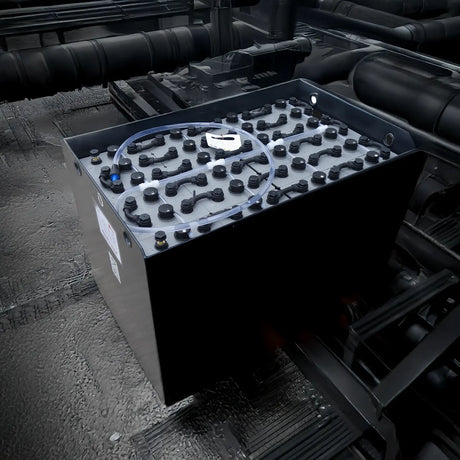Choosing the right forklift battery is crucial for long operating life and low maintenance costs.
But which batteries last the longest , and what's important to maximize battery life ? In this article, we compare lead-acid, gel, and lithium-ion batteries and show which option is best for your business.
We also address important factors such as charging cycles, deep discharge and maintenance that affect battery life.
Which types of batteries are most commonly used in forklifts?
Forklift batteries vary significantly in their technology and maintenance requirements . The three most commonly used variants are:
- Lead-acid batteries – classic, but maintenance-intensive
- Gel batteries – less maintenance, but less powerful
- Lithium-ion batteries – expensive, but efficient and durable
The following table provides a comparison of the most important features :
|
Battery type |
Charging cycles |
maintenance |
Avoid deep discharge? |
Loading time |
Cost |
|---|---|---|---|---|---|
|
Lead-acid |
1,500 - 2,000 |
High (refill water regularly) |
Yes, otherwise damage |
8 - 10 hours |
Cheap |
|
Gel battery |
1,000 - 1,500 |
Low (no need to refill water) |
Yes, otherwise capacity loss |
6 - 8 hours |
Medium |
|
Lithium-ion |
3,000 - 5,000 |
None (maintenance-free) |
No |
1 - 2 hours |
Expensive |
Lead-acid batteries must be regularly refilled with distilled water to maintain a stable electrolyte level . Gel batteries, on the other hand, contain a solid electrolyte , eliminating the need for refilling. Lithium-ion batteries are particularly efficient and offer significantly faster charging times , making them increasingly attractive in many applications.
Why are lead-acid batteries the first choice for forklifts?
Lead-acid batteries are the most common and popular choice for forklifts because they offer proven technology with optimal value for money . Here are the key reasons:
Economic efficiency & acquisition costs
Lead-acid batteries are significantly cheaper to purchase than lithium-ion batteries. Companies with large forklift fleets benefit from this, as the investment costs remain manageable.
High energy efficiency for shift work
Lead-acid batteries are well-suited for many applications, especially multi-shift operations. They can be quickly replaced using swappable battery systems , allowing the forklift to remain operational almost continuously.
Proven & robust technology
Lead-acid technology has been established for decades and is extremely reliable. It works even under demanding conditions, such as warehouses, production facilities, or construction sites.
Easy maintenance & worldwide availability
Lead-acid batteries are readily available and easy to maintain. Spare parts and qualified personnel for maintenance and repair are also widely available. These batteries can also be reconditioned to extend their lifespan.
High recycling rate & sustainability
Lead-acid batteries are over 95% recyclable , making them one of the most environmentally friendly battery types. The established recycling infrastructure ensures the sustainable use of raw materials.
Compatibility with existing forklifts
Most forklifts are designed to run on lead-acid batteries. Switching to lithium-ion often requires expensive modifications or the purchase of new vehicles.
Lead-acid batteries remain the first choice for many companies because they offer an economical, reliable, and sustainable solution for forklift operation. They are perfect for applications with predictable charging times, allow for easy battery replacement, and boast high availability and recyclability.
Lithium batteries: these are the disadvantages
Despite their advanced technology, lithium-ion batteries have several drawbacks that make their use in forklifts less attractive. While technological advances have already improved some weaknesses, certain disadvantages remain problematic.
Fire hazard
Lithium is highly reactive—damaged or improperly charged batteries can overheat and, in rare cases, even cause fires. Therefore, special protective measures are required, especially during charging and storage.
Temperature sensitivity
Lithium-ion batteries are sensitive to temperature fluctuations. They lose significant performance in temperatures below +5 degrees Celsius, while high temperatures above +35 degrees Celsius can shorten their lifespan. This makes them less reliable for outdoor use or in unheated warehouses.
High environmental impact during raw material extraction
The extraction of lithium, cobalt, and nickel is environmentally harmful and involves enormous water consumption, soil destruction, and sometimes questionable working conditions in the mining areas. There is currently hardly any sustainable alternative to conventional raw material extraction.
Difficult disposal and recycling
While lead-acid batteries are over 95% recyclable, there is no established process for recovering all of the raw materials contained in lithium batteries with minimal emissions. They are therefore considered hazardous waste and require complex disposal procedures.
Can any battery be used in any forklift?
Not every battery is compatible with every forklift. Choosing the right battery depends on several factors, including voltage, capacity, design, and weight . A forklift designed for 48V lead-acid batteries cannot simply be powered by a 24V lithium-ion battery . The size of the battery compartment must also match the battery tray dimensions.
Another important consideration is the weight of the battery , as it often serves as a counterweight for the forklift. A battery that is too light could affect the forklift's stability and lead to safety issues. Chargers must also be compatible – a charger for lead-acid batteries may not be able to properly charge a lithium-ion battery, and vice versa.
Therefore, before changing to a different type of battery, you should always check whether the forklift manufacturer has approved the new battery and whether the charger needs to be adjusted accordingly .
What influences battery life in forklifts?
The lifespan of a forklift battery depends on several components . Here are the most important factors you should avoid or optimize :
Charging cycles & deep discharge
Frequent deep discharge of a battery can cause serious damage. Lead-acid and gel batteries, in particular , should not be allowed to remain charged below 30% .
Maintenance & Care
Lead-acid batteries require regular refilling with distilled water . Contaminated water or mineral deposits can disrupt the sulfuric acid to water ratio, thus reducing their service life.
Temperature & Environment
Batteries should not be exposed to excessively high temperatures. Especially in summer, high ambient temperatures can drain the battery faster and shorten charging cycles.
Charging process & chargers
Forklift batteries should always be fully charged , as frequent short-term charging (without a full charge) can be damaging over time. A smart charger can help charge the battery efficiently and increase its lifespan .
Operating times in comparison
|
Battery type |
Average operating time per charge* |
Fast charging possible? |
|---|---|---|
|
Lead-acid |
6 – 8 hours |
No |
|
Gel battery |
5 – 7 hours |
No |
|
Lithium-ion |
8 – 12 hours |
Yes |
*Actual runtime may vary depending on forklift model, usage and environmental conditions.
Finding the right forklift battery – this is how you proceed
Choosing the right forklift battery depends on several factors. Not every battery is compatible with every forklift , so consider the following steps before changing or purchasing a new one:
- Compare the current battery type of your forklift with the possible alternatives.
- Check the voltage, capacity, weight and dimensions of the battery.
- Make sure your charger is compatible or replace it if necessary.
- Consider maintenance and long-term costs.
- When changing batteries, obtain manufacturer approval.


